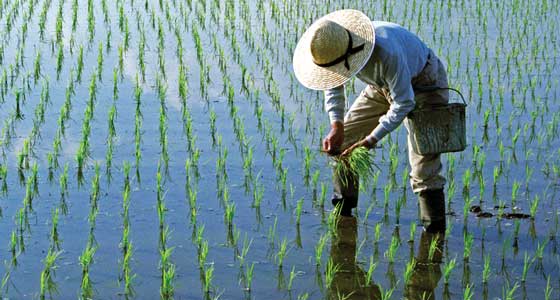Ramping Up Rice Production
IFTNEXT

Rice is a major food crop and staple for billions of people, especially the poor. About 3.5 billion people eat rice, which supplies nearly 20% of global human per capita energy and about 13% of per capita protein. While most rice consumption occurs in Asia, rice is the fastest growing food staple in sub-Saharan Africa and one of the fastest growing foods in Latin America.
Due to the Green Revolution, rice yields increased 2.5% annually from 1965 to 1982. During that time, the average paddy rice yield grew from 2.03 tons per hectare in 1965 to 3.04 tons per hectare in 1982. By 2007, rice yields averaged 4.2 tons per hectare.
To feed a growing global population that is expected to reach 9.8 billion by 2050, rice yields must continue to increase. But there are many challenges that threaten future rice production, including climate change, rising sea levels, pests, plant diseases, water quality, urban sprawl, and more.
Fortunately, researchers are working to find solutions to these challenges.
Rice Genome Research
Earlier this year, researchers published a genetic resource paper in Nature Genetics based on rice genome research that will help to speed up the development of new rice varieties and provide plant breeders with information about key attributes of the varieties.
“The long-term goal of this project is to understand the genome biology and evolution of the wild relatives of rice, and to use this information to breed new varieties of rice that are higher yielding, more nutritious, and sustainable, i.e., require less water, fertilizer and pesticides, can grow on marginal lands, and have reduced greenhouse gas emissions,” says Rod A. Wing, director of the Arizona Genomics Institute, University of Arizona. “The Chinese call such new varieties ‘green super rice’, the Indian’s ‘designer rice’, and the International Rice Research Institute ‘climate ready rice’.”
“A major goal of the rice community is to understand the natural variation that already exists in cultivated rice (over 750,000 different varieties exist and are stored in gene banks across the globe) and its wild relatives and use that natural variation to breed new varieties of green super rice,” says Wing. “Our work opens the door for rapid gene/trait discovery and puts such discoveries in an evolutionary context.” While they made several findings, one that deals with the genetic component of disease resistance may lead to the discovery of long-lasting disease resistance genes in rice, he says.
Now, researchers can use the information from the study to work with rice breeders to develop the next generation of super crops. Wing also says that there are still 10 more wild rice species’ genomes to sequence. “One in particular is very interesting—that of Oryza coarctata. O. coarctata can grow in extremely brackish water and has a species range along the coast from Myanmar to Pakistan. We have already sequenced this genome and are searching for genes that confer salt tolerance.”
Pest Resistance
Insects destroy billions of dollars of rice annually. Researchers from Zhejiang University (China) and Newcastle University (United Kingdom) recently published a study in Nature Plants that shows that it may be possible to enhance rice plants’ resistance to insects by suppressing their serotonin production.
When a rice plant is attacked by pests, it reacts by synthesizing serotonin. Interestingly, the researchers discovered that using gene editing to suppress serotonin production enabled the rice plants to become more resistant to pests. “Our research revealed a strategy to develop new rice cultivars resistant to the most devasting insect pests in rice production, enabling the potential reduction of insecticide use and higher yields,” says study coauthor Qingyao Shu, professor at Zhejiang University. “If this strategy is applied to one-tenth of rice in the world, which is approximately 1.6 million hectares, it could annually translate into saving $640 million dollars in the cost of pesticides and increase the yield of rice by 75 kilograms per hectare.”
The researchers are currently using CRISPR to adjust the serotonin production response in a rice cultivar prior to going to field trials. Also, “since there is only one highly conserved homologue of CYP71A1 [the gene responsible for catalyzing conversion of tryptamine to serotonin] in each genome of cereal crops and since the shikimic acid pathways are conserved across plant species,” the researchers believe that this strategy could also apply to other cereal crops.
IFTNEXT content is made possible through the generous support of Ingredion, the IFTNEXT Platinum Content Sponsor.
